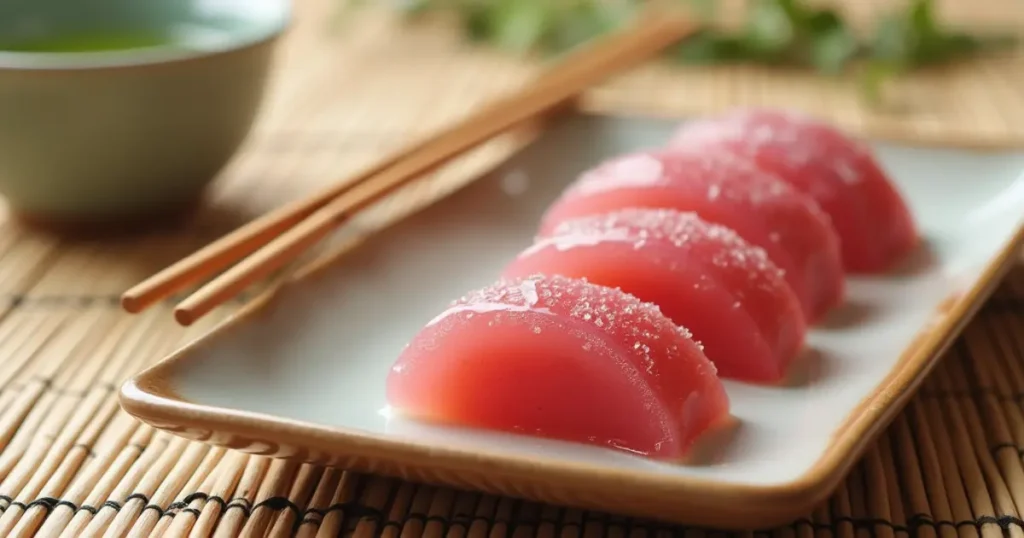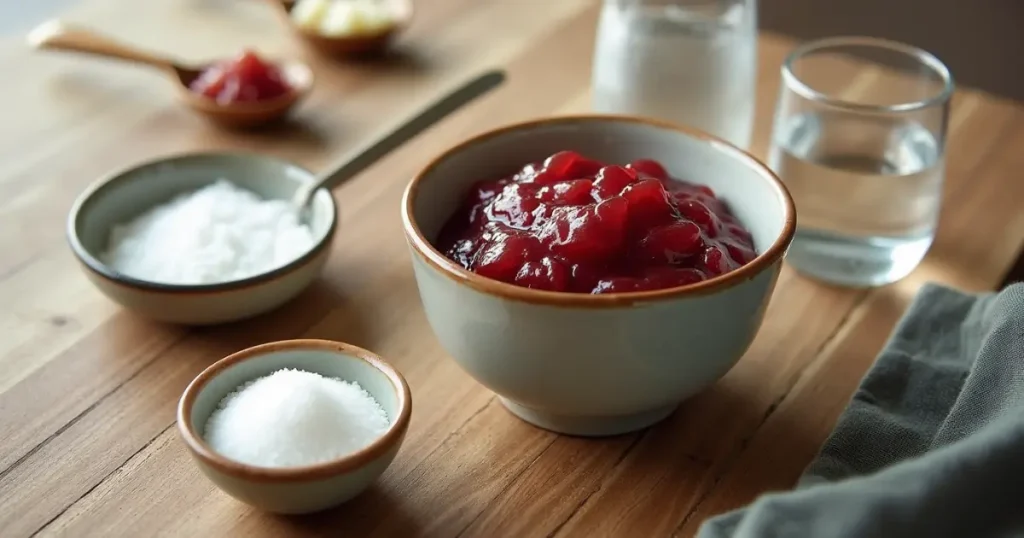
Mizu Yokan: A Refreshing Japanese Jelly Dessert
Table of Contents
Mizu Yokan (水羊羹) is a light and refreshing Japanese dessert that offers a perfect balance of sweetness and texture. Unlike the traditional, denser Yokan, Mizu Yokan has a smooth, jelly-like consistency, making it a popular treat, especially during the hot summer months. Originating from Japan, Mizu Yokan is made primarily from red bean paste, agar-agar (a plant-based gelatin), and sugar, and is known for its refreshing quality and ease of preparation.
The taste of Mizu Yokan is subtly sweet with the rich, earthy flavor of red bean paste, while the agar-agar gives it a firm yet tender texture. Its cool, slightly chewy nature makes it a delightful treat to enjoy after a meal or as a snack.
Why Write This Article?
This article is written to help both beginner and experienced cooks discover the unique and delicious dessert that is Mizu Yokan. Whether you are looking to try a new Japanese recipe or explore a light, refreshing dessert that is simple to make, Mizu Yokan offers a wonderful opportunity to delve into traditional Japanese confectionery. By following this guide, you will be able to create a smooth, jelly-like dessert that not only tastes fantastic but also adds a touch of Japanese culture to your kitchen.
1. List of Ingredients

- Red bean paste (anko) – 1 cup (smooth or chunky, depending on preference)
- Agar-agar powder – 2 teaspoons (or agar-agar strips, about 10g)
- Water – 2 cups
- Sugar – 1/2 cup (adjust to taste)
- Optional: Salt – A pinch (to enhance sweetness and balance flavors)
Substitutes:
- Red bean paste (anko): You can substitute with sweetened adzuki bean paste or other bean pastes, but traditional Mizu Yokan uses red bean paste.
- Agar-agar: If you can’t find agar-agar, you can substitute with gelatin, but the texture will be different, as gelatin gives a softer, more wobbly texture.
- Sugar: If you’d like a healthier alternative, use a sugar substitute such as honey, maple syrup, or stevia. Keep in mind that sweetness levels may vary with substitutes.
2. Servings
This recipe makes approximately 6 servings of Mizu Yokan, depending on the size of each portion.
3. Preparation Time
- Active Time: 15 minutes
- Inactive Time: 2-3 hours (for cooling and setting)
- Total Time: 2 hours 15 minutes – 3 hours 15 minutes
4. Cooking Time
- Cooking Time: 5-10 minutes (to dissolve agar-agar and mix with other ingredients)
- Cooking Temperature: Medium heat (for dissolving agar-agar)
- Cooking Method: Boiling and cooling
5. Step-by-Step Instructions
- Prepare the Agar-Agar:
- In a saucepan, add 2 cups of water and sprinkle the agar-agar powder over the water. Let it sit for a few minutes before turning on the heat. If using agar-agar strips, soak them in warm water for about 10 minutes before using.
- Dissolve the Agar:
- Bring the mixture to a boil over medium heat, stirring frequently. Allow it to boil for about 2-3 minutes to ensure the agar-agar is completely dissolved. Lower the heat and let it simmer for an additional minute.
- Combine with Red Bean Paste:
- In a separate bowl, mix the red bean paste with a little bit of water to smooth it out. Add this mixture to the agar solution. Stir well to combine until you have a smooth, homogenous mixture.
- Sweeten and Adjust:
- Add sugar to the mixture, adjusting to your desired sweetness. Stir until the sugar is fully dissolved. Add a pinch of salt, if desired, to balance the sweetness.
- Pour and Set:
- Pour the mixture into a mold (or individual serving dishes) and allow it to cool to room temperature. Once cool, place the mold in the refrigerator for 2-3 hours to fully set.
- Serve:
- Once set, unmold the Mizu Yokan and cut into squares or desired shapes. Serve chilled for a refreshing treat.
6. Difficulty Level
Easy – This recipe is fairly simple and involves only a few basic ingredients. The primary task is dissolving the agar-agar and ensuring the mixture sets correctly. Even beginners in cooking can make this dessert with success.
7. Presentation and Plating Suggestions
Mizu Yokan can be served in a variety of ways:
- In small slices: Cut the set Mizu Yokan into small cubes or rectangular pieces and arrange them on a traditional Japanese plate or serving tray.
- With garnish: You can add decorative touches like a sprig of mint, a slice of fresh fruit, or even a dusting of matcha powder for extra color and flavor.
- In a mold: For a more elegant presentation, pour the mixture into decorative molds such as small jelly molds or a square pan and slice accordingly.
8. Taste Profile
Mizu Yokan has a mild sweetness with the earthy, slightly nutty flavor of red bean paste. The gelatinous texture, thanks to the agar-agar, provides a smooth, tender chew that’s cool and refreshing. It’s less dense than traditional Yokan, making it perfect for those who prefer a lighter, more delicate dessert. The sugar is balanced by the natural flavors of the red bean paste, while a pinch of salt can enhance the overall taste.
9. Allergen Information or Dietary Restrictions
- Allergens: Mizu Yokan is naturally free from common allergens like dairy and gluten, making it suitable for those with lactose intolerance or gluten sensitivities.
- Dietary Restrictions: The dessert can be made vegan and vegetarian by using agar-agar (which is plant-based) instead of gelatin. Ensure that the red bean paste is sweetened with vegan-friendly sugars for a fully plant-based option.
10. Nutritional Information
- Calories: Approximately 100-120 calories per serving (varies depending on sugar used)
- Carbohydrates: 25g
- Sugar: 20g (adjustable based on preference)
- Protein: 2g
- Fat: 0g
- Fiber: 3g (from the red bean paste)
Please note: Nutritional values will vary depending on the exact ingredients used.
11. Storage and Leftover Tips
- Storage: Store any leftover Mizu Yokan in an airtight container in the refrigerator for up to 5 days.
- Freezing: Mizu Yokan is not ideal for freezing, as the texture can change after thawing. It’s best enjoyed fresh or within a few days of making it.
- Leftovers: If the jelly begins to soften or lose its texture after a few days, you can re-chill it, though the texture may not be as firm.
12. Troubleshooting
- Mizu Yokan is too soft and doesn’t set properly: If your Mizu Yokan doesn’t set, you may not have used enough agar-agar. Adjust the amount of agar in the recipe to suit your preferred firmness, and ensure it’s completely dissolved during cooking.
- Too sweet or too bland?: The level of sweetness can vary depending on the sweetness of your red bean paste and your sugar preference. Taste the mixture before setting it and adjust the sugar accordingly.
- Grainy texture?: This can happen if the red bean paste isn’t well mixed with the agar solution. Ensure it is properly smooth before combining it with the agar.
13. Cultural or Historical Context
Mizu Yokan has its roots in Japanese history, where it was often prepared during the summer months as a cooling dessert. The term “Yokan” refers to a traditional Japanese jelly-like sweet made from red beans, sugar, and agar-agar, but Mizu Yokan is a variation that’s much lighter and more refreshing. The dessert is typically enjoyed in the warmer months as a way to cool down and refresh the body.
Mizu Yokan is also associated with traditional Japanese sweets called wagashi, which are often served with green tea during tea ceremonies. This dessert is a great example of how Japanese culture values simplicity, balance, and the use of natural ingredients to create a satisfying yet delicate treat.

